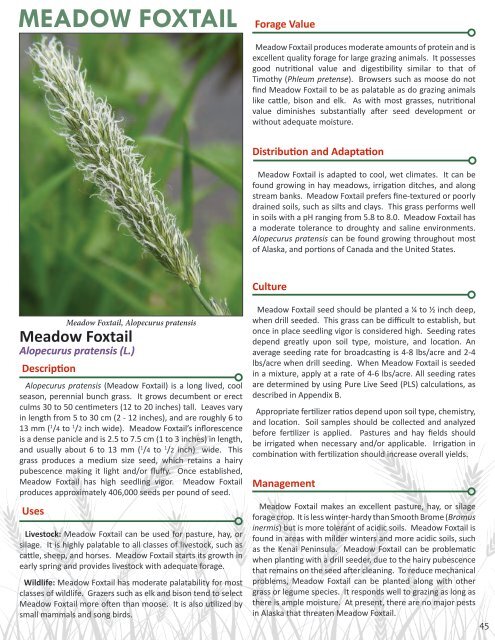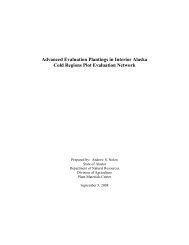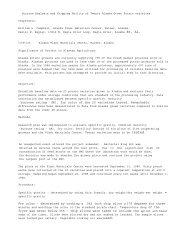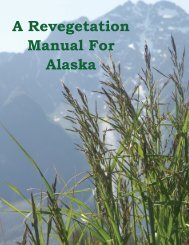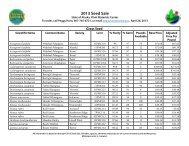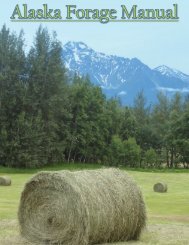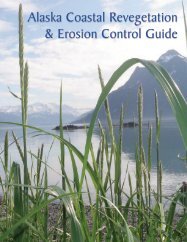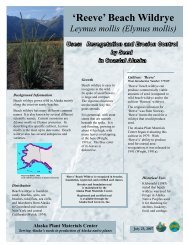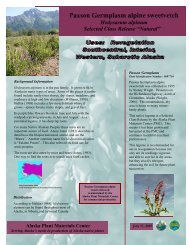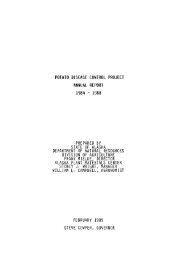Alaska Forage Manual - Alaska Plant Materials Center - State of ...
Alaska Forage Manual - Alaska Plant Materials Center - State of ...
Alaska Forage Manual - Alaska Plant Materials Center - State of ...
You also want an ePaper? Increase the reach of your titles
YUMPU automatically turns print PDFs into web optimized ePapers that Google loves.
MEADOW FOXTAIL<br />
<strong>Forage</strong> Value<br />
Meadow Foxtail produces moderate amounts <strong>of</strong> protein and is<br />
excellent quality forage for large grazing animals. It possesses<br />
good nutritional value and digestibility similar to that <strong>of</strong><br />
Timothy (Phleum pretense). Browsers such as moose do not<br />
find Meadow Foxtail to be as palatable as do grazing animals<br />
like cattle, bison and elk. As with most grasses, nutritional<br />
value diminishes substantially after seed development or<br />
without adequate moisture.<br />
Distribution and Adaptation<br />
Meadow Foxtail is adapted to cool, wet climates. It can be<br />
found growing in hay meadows, irrigation ditches, and along<br />
stream banks. Meadow Foxtail prefers fine-textured or poorly<br />
drained soils, such as silts and clays. This grass performs well<br />
in soils with a pH ranging from 5.8 to 8.0. Meadow Foxtail has<br />
a moderate tolerance to droughty and saline environments.<br />
Alopecurus pratensis can be found growing throughout most<br />
<strong>of</strong> <strong>Alaska</strong>, and portions <strong>of</strong> Canada and the United <strong>State</strong>s.<br />
Culture<br />
Meadow Foxtail, Alopecurus pratensis<br />
Meadow Foxtail<br />
Alopecurus pratensis (L.)<br />
Description<br />
Alopecurus pratensis (Meadow Foxtail) is a long lived, cool<br />
season, perennial bunch grass. It grows decumbent or erect<br />
culms 30 to 50 centimeters (12 to 20 inches) tall. Leaves vary<br />
in length from 5 to 30 cm (2 - 12 inches), and are roughly 6 to<br />
13 mm ( 1 /4 to 1 /2 inch wide). Meadow Foxtail’s inflorescence<br />
is a dense panicle and is 2.5 to 7.5 cm (1 to 3 inches) in length,<br />
and usually about 6 to 13 mm ( 1 /4 to 1 /2 inch) wide. This<br />
grass produces a medium size seed, which retains a hairy<br />
pubescence making it light and/or fluffy. Once established,<br />
Meadow Foxtail has high seedling vigor. Meadow Foxtail<br />
produces approximately 406,000 seeds per pound <strong>of</strong> seed.<br />
Uses<br />
Livestock: Meadow Foxtail can be used for pasture, hay, or<br />
silage. It is highly palatable to all classes <strong>of</strong> livestock, such as<br />
cattle, sheep, and horses. Meadow Foxtail starts its growth in<br />
early spring and provides livestock with adequate forage.<br />
Wildlife: Meadow Foxtail has moderate palatability for most<br />
classes <strong>of</strong> wildlife. Grazers such as elk and bison tend to select<br />
Meadow Foxtail more <strong>of</strong>ten than moose. It is also utilized by<br />
small mammals and song birds.<br />
Meadow Foxtail seed should be planted a ¼ to ½ inch deep,<br />
when drill seeded. This grass can be difficult to establish, but<br />
once in place seedling vigor is considered high. Seeding rates<br />
depend greatly upon soil type, moisture, and location. An<br />
average seeding rate for broadcasting is 4-8 lbs/acre and 2-4<br />
lbs/acre when drill seeding. When Meadow Foxtail is seeded<br />
in a mixture, apply at a rate <strong>of</strong> 4-6 lbs/acre. All seeding rates<br />
are determined by using Pure Live Seed (PLS) calculations, as<br />
described in Appendix B.<br />
Appropriate fertilizer ratios depend upon soil type, chemistry,<br />
and location. Soil samples should be collected and analyzed<br />
before fertilizer is applied. Pastures and hay fields should<br />
be irrigated when necessary and/or applicable. Irrigation in<br />
combination with fertilization should increase overall yields.<br />
Management<br />
Meadow Foxtail makes an excellent pasture, hay, or silage<br />
forage crop. It is less winter-hardy than Smooth Brome (Bromus<br />
inermis) but is more tolerant <strong>of</strong> acidic soils. Meadow Foxtail is<br />
found in areas with milder winters and more acidic soils, such<br />
as the Kenai Peninsula. Meadow Foxtail can be problematic<br />
when planting with a drill seeder, due to the hairy pubescence<br />
that remains on the seed after cleaning. To reduce mechanical<br />
problems, Meadow Foxtail can be planted along with other<br />
grass or legume species. It responds well to grazing as long as<br />
there is ample moisture. At present, there are no major pests<br />
in <strong>Alaska</strong> that threaten Meadow Foxtail.<br />
45


